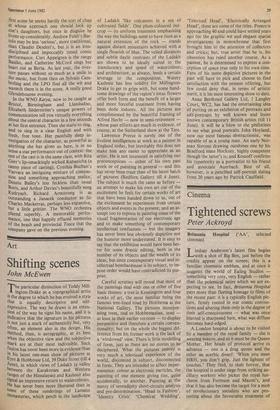Art
Shifting scenes
John McEwen
he particular distinction of Teddy Mill-
ington-Drake as a topographical artist is the degree to which he has evolved a style that is equally descriptive and self- expressive. The way he draws is an exten- sion of the way he signs his name, and it is indicative that the signature in his pictures Is not just a mark of authenticity but, very often, an element also in the design. His Method, then, is autographic, at its best When the objective view and the subjective Mark are at their most indivisible. Such fusion has never been more in evidence than In his latest one-man show of pictures at Eyre & Hobhouse Ltd, 39 Duke Street (till 4 June), in which views of Ladakh (a valley between the Karakoram and Western ranges of the Himalayas) and Kashmir also signal an impressive return to watercolours. He has never been more liberated than in some of these renderings of Lamaist monasteries, which perch in the landscape
of Ladakh 'like volcanoes in a sea of cultivated fields'. One plum-coloured out- crop — its uniform treatment emphasising the way the buildings seem to have risen as a natural extension of the rock — stands against distant mountains achieved with a single flourish of blue. The veiled distances and subtle daylit contrasts of the Ladakh are shown to be ideally suited to the translucency and speed of watercolour; and architecture, as always, lends a certain leverage to the composition. Watery Kashmir has less solidity for Millington- Drake to get to grips with, but some hand- some drawings of the region's lotus flowers offer both form and the benefit of a larger and more forceful treatment from having been done indoors. All the pictures are complimented by the beautiful framing of Alfred Hecht — now in semi-retirement — whose past efforts are much in evidence, of course, at the Sutherland show at the Tate.
Lawrence Preece is surely one of the liveliest intelligences at work as a painter in England today, but inevitably this does not make him any easier to appreciate as an artist. He is not interested in satisfying our preconceptions — either of his own past work or of painting in general — and this has never been truer than of his latest batch of pictures (Redfern Gallery till 4 June). The subject is much the same as before — an attempt to make his own art out of the excitement he feels for certain works of art that have been handed down to us, out of the excitement he experiences from certain objects and events in the present; and an at- tempt too to express in painting some of the visual fragmentation of our electronic age and to make something of contemporary intellectual confusions — but the imagery has never been less obviously depictive nor the humour more understated. It is easy to say that the exhibition would have been bet- ter for some drastic editing, both in the number of its objects and the wealth of its ideas, but since contemporary visual and in- tellectual bombardment is its subject, to im- pose order would have contradicted its pur- pose.
Careful scrutiny will reveal that most of the paintings deal with one or other of five basic themes: a tree in Kennington and four works of art, the most familiar being the famous tree-lined road by Hobbema at the National Gallery. The pictures incorpor- ating trees, real or Hobbemanian, tend at least in their earlier versions — to display perspective and therefore a certain conven- tionality; but on the whole the biggest dif- ference from his former work is the lack of a 'windowed' view. There is little modelling of form, just as there are no stories to be deciphered. What the pictures convey is very much a televisual experience of the world, disjointed in subject, disconnected in form. They are intended to affect imper- manence: colour as electronic particles, the painting of one element giving rise, quite accidentally, to another. Painting at the mercy of serendipity short-circuits analysis and pre-determination. 'Head in Fashion', 'Identity Crisis' Chemical Wedding',
'Televised Head', 'Electrically Arranged Head', these are some of the titles. Preece is approaching 40 and could have settled years ago for the graphic wit and elegant spatial investigations in monochrome that first brought him to the attention of collectors and critics; but, true artist that he is, his obsession has ruled another course. As a painter, he is determined to express a con- ception of space true only to his own time. Fans of his more depictive pictures in the past will have to pick and choose to find satisfaction with the present offering, but few could deny that, in terms of artistic merit, it is his most interesting show to date.
Anne Berthoud Gallery Ltd, 1 Langley Court, WC2, has had the entertaining idea of putting on an exhibition of portraits and self-portraits by well known and lesser known contemporary British artists (till 11 June). It will be a blow to the philistines to see what good portraits John Hoyland, now our most famous abstractionist, was capable of as a young man. An early Nor- man Stevens drawing outshines one by his Bradford mate Hockney, highly competent though the latter's is; and Kossoff confirms his superiority as a portraitist to his friend and associate Auerbach. Best of all, however, is a pencilled self-portrait dating from 20 years ago by Patrick Caulfield.






































 Previous page
Previous page